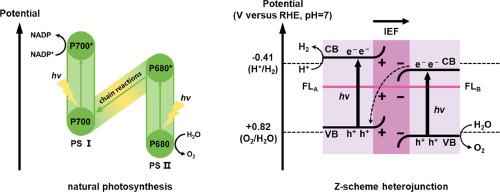Interface engineering of Z-scheme heterojunction for photocatalytic water splitting
IF 6.3
3区 综合性期刊
Q1 Multidisciplinary
引用次数: 0
Abstract
Photocatalytic water splitting technology can directly convert solar energy into H2 via a zero-carbon route, offering a sustainable solution for solar utilization and H2 supply. Among various developed photocatalysts, Z-scheme heterojunction mimicking natural photosynthesis by combining two dissimilar semiconductors for redox reactions in series has unequivocally demonstrated its superiority in enhanced charge transfer, robust redox driving force, and wide optical absorption range. A comprehensive understanding on the fundamental principles of interface engineering between semiconductor components is the key to construct an efficient Z-scheme heterojunction. By focusing on different types of semiconductors, this article thoroughly expounds the coupling principles of components in binary mediator-free and ternary solid-mediator Z-scheme heterojunctions for photocatalytic water splitting, from the viewpoint of band structure alignment and interfacial electric field design. In addition to the well summarized research progresses in recent years, perspectives on the challenges and opportunities for developing advanced Z-scheme heterojunctions are provided.

用于光催化水分离的 Z 型异质结的界面工程设计
光催化水分解技术可以通过零碳路线直接将太阳能转化为氢气,为太阳能利用和氢气供应提供了可持续的解决方案。在各种已开发的光催化剂中,通过组合两种不同的半导体进行串联氧化还原反应来模拟自然光合作用的Z-scheme异质结在电荷转移增强、氧化还原驱动力强、光吸收范围宽等方面的优势得到了明确的证明。全面了解半导体元件之间界面工程的基本原理是构建高效z型异质结的关键。本文以不同类型的半导体为研究对象,从带结构取向和界面电场设计的角度,深入阐述了光催化水分解中二元无介质和三元固体介质z型异质结中各组分的耦合原理。总结了近年来的研究进展,展望了发展先进z型异质结面临的挑战和机遇。
本文章由计算机程序翻译,如有差异,请以英文原文为准。
求助全文
约1分钟内获得全文
求助全文
来源期刊

Fundamental Research
Multidisciplinary-Multidisciplinary
CiteScore
4.00
自引率
1.60%
发文量
294
审稿时长
79 days
期刊介绍:
 求助内容:
求助内容: 应助结果提醒方式:
应助结果提醒方式:


